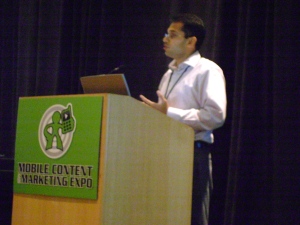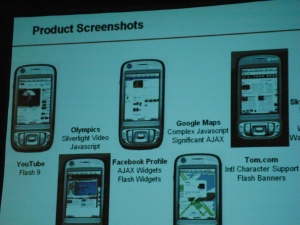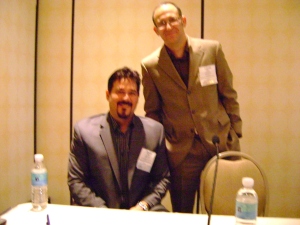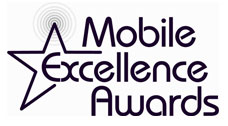From Mobile Content & Marketing Expo
San Jose, CA—Assaf Tarnopolsky, vp of mobile programming & digital product development at Sony Pictures Television International, gave the afternoon’s keynote address. SPTI is heavily involved in creating and distributing original mobile content, from the immensely popular “After World” to the new “Gemini Division.”
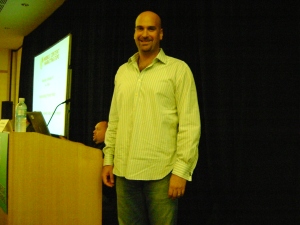
Assaf Tarnopolsky, just before keynote
Tarnopolsky recalls when he entered the industry in 2005; when he told his friends that he was going to be putting TV on the phone, he remembers getting a lot of very strange looks and comments as to why anyone would want to do that. “Luckily, it seems to be working out,” he said. “People do want and need that, and you’re here because you believe that.”
“Media services–music, movies, TV–will become ubiquitous on mobile devices the way that mobile devices themselves have become ubiquitous and features like cameras have become ubiquitous on those devices,” he said.
Tarnopolosky tried to give attendees the studio’s view of creating mobile and digital content creation. “We’re experimenting, we’re trying new things and in the process learning,” he said. “We’re trying to be in the vanguard as models and new consumption patterns emerge.”
The good news is that metrics are moving up, said Tarnopolsky. “Telcos are making massive investments in new networks like 3G, the new standard. The overall growth rate of subscriptions is slowing due to saturation, 3G subscriptions are expected to double in the next couple of years.” He also pointed to the advent of 4G and its promise of broadcast video, and new handsets enabling companies like Sony Pictures Television International to deploy rich media.
The biggest game changer now is the iPhone, he said, adding to the chorus of others saying just this today. “There’s been a fundamental shift in the public’s understanding of media-on-the-go,” he said. “Even my mother and mother-in-law see people using mobile media and understand the utility.”
Since SPTI is an international company, Tarnopolsky has a view to what’s going on with mobile TV in places like France with telecom provider Orange. “In South Korea, there’s a ton of usage and a lot of money being made,” he said. “They’re to be 20 percent more business with one-sixth the population. It’s big business and moving in the right direction. Twenty-two percent of their population watch mobile TV on a regular basis and for over an hour today, versus our more snack-sized mobile content.”
Looking into the future for the commercialization of mobile content, Tarnopolsky suggested looking at fast-growing markets in India, China, and Brazil or even at the youth in the USA. “These are kids who probably watch broadcast TV, but few have laptops of DSL connections but a whole lot of them have mobile devices,” he said. “With 1.2 billion mobile devices will be sold over the world this year, it’s easy to see that mobile devices will be the connective tissue of modern communications.”
Content is king, goes the adage in Hollywood. “It is a critical link in the chain of getting people to want to get involved,” he said. “Time saving and productivity applications will be the killer apps for some time to come.” But, as mobile devices become more ingrained in our lives–lifeware, so to speak–everything we’re used to doing on the Internet we’ll also be doing on mobile devices.
Tarnopolsky said that content that has done well so far on the mobile platform is generally live or almost-live and short. “Current events, sports and finance are the kinds of things that drive trial and adoption of mobile media today,” he said. “It’s that perishable information, and that’s totally logical.” Brands also drive adoption, he noted. “When you go to CNN Mobile and know Wolf Blitzer is going to be on, and you know and trust him, you’ll feel good.” Short content from music videos to stand-up comedy also does well because it’s consumable in snack-sized pieces. “Personal and relevant will be the two kinds of content that will succeed moving forward–and those are the two words that describe the mobile phone itself.”
The studio’s challenge is to make that content that’s personal, relevant and, of course, good. It has to be easy to find and use, and we’re not really there as an industry. Wouldn’t it be nice if it had DVR functionality like my Tivo at home? And even better if it were free. “It’s clear that the mobile version of “The Godfather” has arrived, unless you think “Chocolate Rain” is as good as it gets, which I don’t,” he added. “At Sony we have boots on the ground around the world so we can try things in different markets.”
The four pillars of what SPTI is doing is original digital content, games, networks and catalog extensions. Catalog extensions is the attempt to mine the existing content sitting in the archive. Minisode Network is “the shows you love, only shorter.” SPTI takes classic shows like “Charley’s Angels,” “The Facts of Life,” “Starsky & Hutch,” all the classic shows, and edit them down to 5-minute minisodes. “They’re eminently consumable on the mobile phone.”
With current TV programming, SPTI is looking for ways to extend the programming onto the mobile phone, with shows like “Rescue Me,” “The Tudors” and others. “What kind of mobile programming could we deploy that people would watch?” he asked. “We’re spending time thinking about that.”
Outside the U.S., in 50 countries, SPTI runs three principal network brands: Animax, AXN and Sony Entertainment Television. SPTI is deploying the mobile version of these linear channels. “These brands are composed largely of U.S. content,” he said. “And we typically don’t have the mobile broadcasting rights, so we acquire those rights or do new deals for new content, or programming our own original programming.”
That project started 18 months ago and they’re in 20 countries, primarily with Animax, with shows anime and other animation content to the 13 to 24 demographic, the ones least likely to have control of the remote control at night and also the ones most likely to feel comfortable using the mobile phone to watch content.
“Mobile games are a no-brainer,” said Tarnopolsky who said they’ve created games for Hancock, Spider-Man and other properties. “This is an obvious way for us to extend our brands and make money in one of the most established areas of mobile.”
Last but not least is original digital productions, what he calls “the forward looking” part of the strategy. They’re trying to create properties with story-driven features that engage audiences and work across multiple platforms. Audiences interact with media in different ways; the native-mobile and digital audiences feel at ease watching a TV show and texting or IMing their friends while they watch. “We’re trying to bring a modern sensibility to what they watch,” he said, “And have what we’ve learned inform the production process. It’s also to do our part to push along our clients and their clients, the advertisers, to attach themselves to new media knowing it’s been produced by a top professional entertainment company.” He noted that big companies like Proctor & Gamble will have a hard time buying against YouTube, “because they don’t know what they’re buying. A new media environment from a company like SPTI is a more likely match.”
“Afterworld” was SPTI’s first mobile product, with 130 episodes telling a hero’s journey in a post -apocalyptic world. The protagonist tracks Russell Shoemaker’s progress home from New York in a world in which people and technology have vanished. The animation was created with mobile distribution in mind, so the shots are tight and the movement is slow, to accommodate the networks and phones of two or three years ago. “And it came with cool stuff on the web, with deep engagement story complements,” he said. “It hadn’t really been done before, and the challenges in producing it and deploying it were many. We made some money, our client made some money and we learned quite a bit.” “Afterworld” was also sold to broadcasters, telcos and other platforms.
The first licensee was TV One in Australia. They operate the SciFi channel and an online sci-fi website. “As the episode was being played, new story elements were posted to the website, to watch consumer patterns,” he said. “As we hoped, when the episode was done, audiences flocked to the website and page views spiked and view times were 50 percent longer than before. The next day, catch-up episodes were available, and people were downloading those episodes, so many that it was just behind “The Simpsons” and “The Family Guy”.”
The next original mobile series is “Gemini Division,” exclusively on CBS.com in the U.S., and co-produced by SPTI which is distributing it everywhere outside the U.S. “This takes the lessons of “Afterworld” and makes a better story,” he said. “We started with a great story – a sci-fi story set 5 ninutes into the future,” he said, noting that the lead is played by Rosario Dawson, “a bona fide movie star.” “She’s a NY City cop who falls in love with a mysterious stranger. “Then things get weird,” said Tarnopolsky who urged viewers to go to CBS.com and find out more. “We discovered with “Afterworld” that 130 episodes was just too long,” he said, “Consumer attachment waned at the half-way point.” For “Gemini Division,” they added more casual games and a graphic novel, ancillary story elements that consumers can interact with.
“And we took it a step further,” he said. “If you’re a registered member, you’ll receive text messages from characters in the story that are clues. If you’re into sci-fi and conspiracies, you can follow the clues down the rabbit hole into an alternative world where you can try to discover what’s going on and help solve the mystery.”
Next up is tackling the funny: “Woke Up Dead,” a modern vampire tale, following a young man who wakes up and discovers he’s dying. He and his intrepid band of friends try to piece him back together.
“Coming full circle on the mobile media industry and why it’s taking so much longer to blow up than we hoped,” he said. “Why is that? It would seem all the pieces are in place for the industry. I think there’s a vicious cycle of mis-aligned objectives among the stakeholders. Consumers don’t want to pay more for content that they feel they can get free, carriers don’t want to risk their networks, and content owners want to get paid every time they distribute a piece of content on any platform. So the advertisers are left out of an industry segment they should be licking their chops over, one where the connection to the consumer is relevant, personal and constant. New technology allows advertisers to know exactly what their consumers are doing. To me, it’s mind-boggling that advertising hasn’t come in sooner.”
“Subscription costs are still high, discovery of content and how to use it is behind, consumers aren’t flocking to the content because of this, and advertisers naturally stay out because the business is small and there isn’t a critical mass of users. That has got to change. Studios always want to make premium content. The networks and cable systems rely on advertising as a core piece of their business. I’d argue that this TV/cable that we’re so used to will, in some shape or form, come to exist in the mobile eco-system, and as advertisers come in, it’ll be the rising tide that lifts all of us.”
“I can imagine a carrier, a studio, a handset manufacturer working together to try to blow the business open,” he concluded. “It could look like pricing data services lower, a studio taking less up front or handset manufacturers providing video-enabled devices at cheaper prices. As consumer interest spikes, advertisers will come running as fast as they can, and then the advertisers will be in this business as well. As JupiterResearch perfects reporting and metrics, advertisers will benefit from that. And the whole industry will move up.”
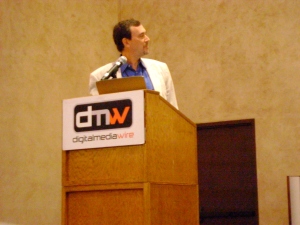

 distributed via cell phone (as well as e-books and audio books), has been in the print publishing business for 15 years for Rodale, Element Books and Quarto. Schmidt and partner Allan Penn joined literary agent Lori Perkins to start Ravenous Romance. MobilizedTV spoke to Schmidt about the ins and outs of digital publishing, online and on mobile.
distributed via cell phone (as well as e-books and audio books), has been in the print publishing business for 15 years for Rodale, Element Books and Quarto. Schmidt and partner Allan Penn joined literary agent Lori Perkins to start Ravenous Romance. MobilizedTV spoke to Schmidt about the ins and outs of digital publishing, online and on mobile.



